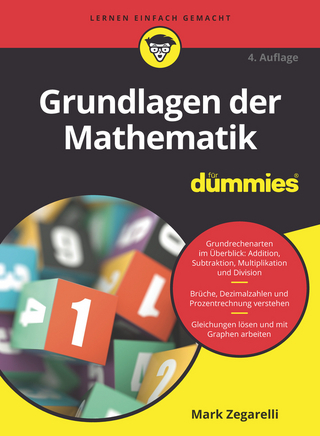
Finite Mathematics
John Wiley & Sons Inc (Verlag)
978-0-470-64625-0 (ISBN)
- Titel z.Zt. nicht lieferbar
- Versandkostenfrei innerhalb Deutschlands
- Auch auf Rechnung
- Verfügbarkeit in der Filiale vor Ort prüfen
- Artikel merken
Sullivan's Finite Mathematics 11e continues to demonstrate how mathematics applies to various fields of study through its engaging writing style and relevant applications. Packed with real data and real-life applications to business, economics, social and life sciences, the text gives a rich survey of mathematical analysis techniques used in the working world and applies to a wide student base.
Michael Sullivan is Professor Emeritus in the Department of Mathematics and Computer Science at Chicago State University where he taught for 35 years before retiring a few years ago. Dr. Sullivan is a member of American Mathematical Society, the Mathematical Association of America, and the American Mathematical Association of Two Year Colleges. He is President of Text and Academic Authors Association and represents that organization on the Authors Coalition of America, Mike has been writing textbooks in mathematics for over 30 years. He currently has 13 books in print: 3 texts with John Wiley & Sons and 10 with Prentice-Hall. Six of these titles are co-authored with his son, Michael Sullivan III. He has four children: Kathleen, who teaches college mathematics; Michael, who teaches college mathematics, Dan who is a Prentice-Hall sales representative, and Colleen, who teaches middle school mathematics. Nine grandchildren round out the family.
Chapter 1: Linear Equations 1.1. Lines
1.2. Pairs of Lines
1.3. Applications to Business and Economics
1.4. Scatter Diagrams; Linear Curve Fitting
Chapter Review
Chapter Project
Chapter 2: Systems of Linear Equations
2.1 Systems of Linear Equations: Substitution; Elimination
2.2 Systems of Linear Equations: Gauss-Jordan Method
2.3 Systems of m Linear Equations Containing n Variables
Chapter Review
Chapter Project
Chapter 3: Matrices
3.1 Matrix Algebra
3.2 Multiplication of Matrices
3.3 The Inverse of a Matrix
3.4 Applications in Economics (the Leontief Model), Accounting, and Statistics (the Method of Least Squares)
Chapter Review
Chapter Project
Chapter 4: Linear Programming with Two Variables
4.1 Systems of Linear Inequalities
4.2 A Geometric Approach to Linear Programming Problems
Chapter Review
Chapter Project
Chapter 5: Linear Programming: Simplex Method
5.1 The Simplex Tableau; Pivoting
5.2 The Simplex Method; Solving Maximum Problems in Standard Form
5.3 Solving Minimum Problems Using the Daily Principle
5.4 The Simplex Method for Problems Not in Standard Form
Chapter Review
Chapter Project
Chapter 6: Finance
6.1 Interest
6.2 Compound Interest
6.3 Annuities; Sinking Funds
6.4 Present Value of an Annuity; Amortization
6.5 Annuities and Amortization Using Recursive Sequences
Chapter Review
Chapter Project
Chapter 7: Probability
7.1 Sets
7.2 The Number of Elements in a Set
7.3 The Multiplication Principle
7.4 Sample Spaces and the Assignment of Probabilities
7.5 Properties of the Probability of an Event
7.6 Expected Value
Chapter Review
Chapter Project
Chapter 8: Bayes' Theorem; The Binomial Probability Model
8.1 Conditional Probability
8.2 Independent Events
8.3 Bayes' Theorem
8.4 Permutations
8.5 Combinations
8.6 The Binomial Probability Model
Chapter Review
Chapter Project
Chapter 9: Statistics
9.1 Introduction to Statistics: Data and Sampling
9.2 Representing Qualitative Data Graphically: Bar Graphs; Pie Charts
9.3 Organizing and Displaying Quantitative Data
9.4 Measures of Central Tendency
9.5 Measures of Dispersion
9.6 The Normal Distribution
Chapter Review
Chapter Project
Chapter 10: Markov Chains; Games
10.1 Markov Chains and Transition Matrices
10.2 Regular Markov Chains
10.3 Absorbing Markov Chains
10.4 Two-Person Games
10.5 Mixed Strategies
10.6 Optimal Strategy in Two-Person Zero-Sum Games with 2 X 2 Matrices
Chapter Review
Chapter Project
Chapter 11: Logic
11.1 Propositions
11.2 Truth Tables
11.3 Implications; The Biconditional Connective; Tautologies
11.4 Arguments
11.5 Logic Circuits
Chapter Review
Chapter Project
Appendix A: Review
A.1 Real Numbers
A.2 Algebra Essentials
A.3 Exponents and Logarithms
A.4 Recursive Defined Sequences: Geometric Sequences
Appendix B: Using LINDO to Solve Linear Programming Problems
Appendix C: Graphing Utilities
C.1 The Viewing Rectangle
C.2 Using a Graphing Utility to Graph Equations
C.3 Square Screens
C.4 Using a Graphing Utility to Graph Inequalities
Answers to Odd-Numbered Problems
Photo Credits
Index
| Verlagsort | New York |
|---|---|
| Sprache | englisch |
| Maße | 204 x 255 mm |
| Gewicht | 1446 g |
| Themenwelt | Mathematik / Informatik ► Mathematik ► Allgemeines / Lexika |
| ISBN-10 | 0-470-64625-X / 047064625X |
| ISBN-13 | 978-0-470-64625-0 / 9780470646250 |
| Zustand | Neuware |
| Informationen gemäß Produktsicherheitsverordnung (GPSR) | |
| Haben Sie eine Frage zum Produkt? |
aus dem Bereich


